Crown Jewels: Carrera GT, Enzo, SLR McLaren

Faenza, a small town a short distance from the city gates of Bologna, takes in the cool morning air. On the Piazza del Popolo, there’s Palazzo, a small cafe tucked away under medieval arcades. Giorgio sits in front of a cappuccino. Francesco puffs on his cigar. Now and then someone strolls across the tile-clad square. It’s Monday or Tuesday. Maybe even Wednesday. Who cares?
This story originally appeared in the July, 2004 issue of Road & Track - Ed.
A Ferrari, a Porsche and a Mercedes-Benz reach the Piazza in the early hours. But not just any ordinary sports cars, these are the icons of their respective marques- Enzo, Carrera GT, SLR McLaren. Super sports cars, as the people call them. Their arrival is heralded by a piercing noise. Slicing their way through the narrow streets, they hit the Piazza like meteorites. Faenza no longer sleeps.
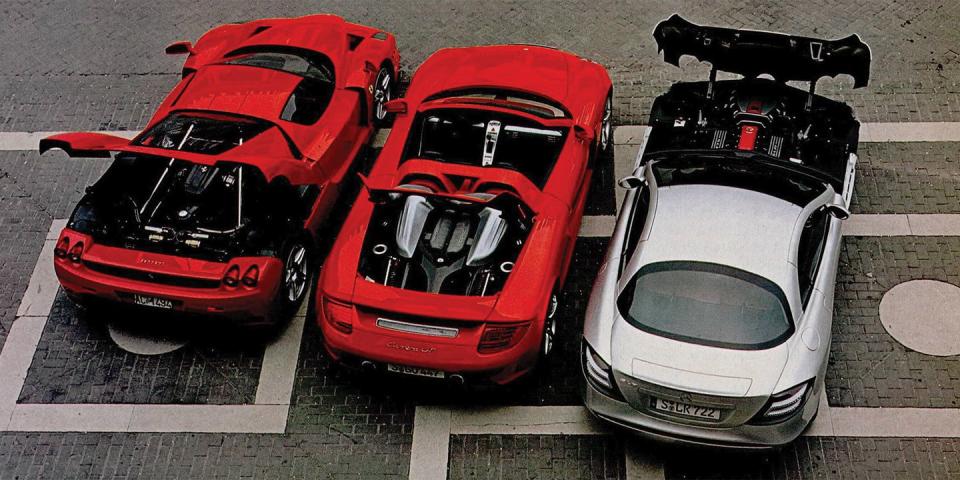
Low, wide and with a deafening roar, these three know how to make an entrance. The two red ones emit a dry bark as they take possession of the Piazza. The Ferrari Enzo gives out a high cry before the 6.0-liter V-12 falls silent. The Porsche Carrera GT driver rocks his foot on the gas pedal to keep the 5.7-liter V-10 engine alive. It yells, rattles hoarsely before returning to idling speed. The mid-mounted engine takes another quick breath, then suddenly falls silent. So abrupt, it’s as if someone had picked up a pair of scissors and cut through the soundtrack. What else could one expect from race-bred engines?
The silver-colored Mercedes-Benz SLR McLaren is kept idling, its front mid-mount engine lopes in a sonorous tone. Then the driver shifts the lever of the automatic 5-speed gearbox to Park. An instant later the SLR falls silent. True to its Mercedes heritage, the SLR McLaren comes with an engine that is as calm as it is strong. This supercharged 5.4-liter V-8 engine from Mercedes’ racing department produces an impressive 617 bhp with little song and dance.
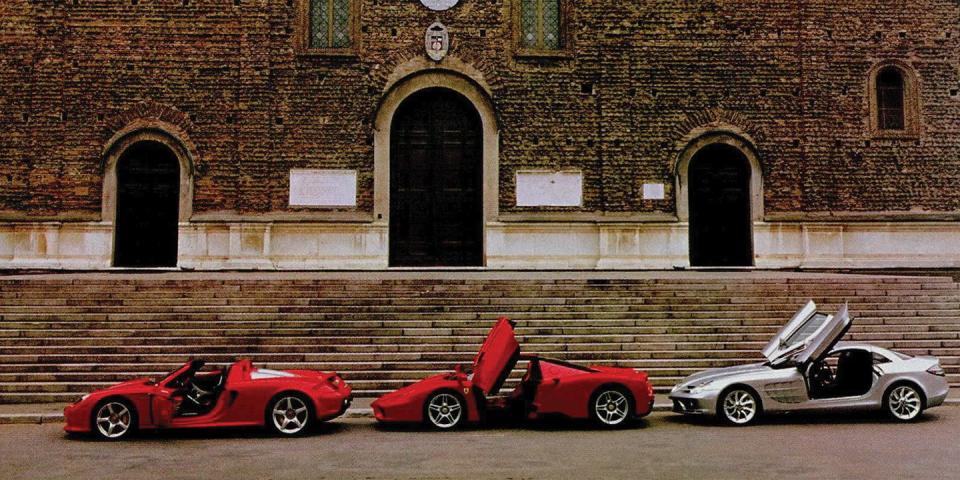
Three doors open with near synchronized timing-the Ferrari and the Mercedes doors swing upward, the Porsche more traditionally to the side-revealing cabins that seem fairly conventional at first glance. But each embodies its own brand-specific racing car philosophy with distinct criteria having evolved from its past.
In the Enzo, state-of-the-art Formula 1 technology is fused with the tradition of such legendary GT cars as the GTO, F40 and F50 to create a unique, yet accessible machine. Of course its accessibility needs to be understood in brand-specific terms: a Ferrari has always been a rare commodity. And the racing car named for the company’s founder is no exception. While street legal, only 399 models were made, ensuring that a sighting on the road will indeed be a rare event. As always, this small series is sold to handpicked buyers, friends of the factory, so to speak, and obviously, the price tag of roughly $650,000 failed to have a deterrent effect.

Porsche’s mid-engine GT is based on a V-10 concept developed in 1999 for Le Mans, a program that was scrapped due to costs. This motorsports pedigree is evident in its light metal crankcase and titanium connecting rods. The short-stroke engine weighs a mere 282 lb. and lies extremely low in front of the rear axle. Its output: 605 bhp at 8000 rpm. Just like the Ferrari and Mercedes SLR, the Carrera GT is clad in strong carbon-fiber bodywork. Yet Porsche knows only too well that unlike the Enzo, very few of the 1500 Carrera GTs built over the next three years will go to museum owners. The greater numbers will also ensure more sightings on the street and, of course, trackside during track days. Porschephiles will happily pay about $440,000 to prove that point.
While cars like the Enzo and Carrera GT are expected and almost demanded from marques like Ferrari and Porsche, Mercedes-Benz is testing the very limits of its brand identity with the SLR McLaren. In terms of proportions as well as details, it bears a strong resemblance to the Mercedes SL, albeit one on steroids: the four eyed face, the centrally mounted Mercedes star at the front, and the lateral gills to vent brakes and engine, styling cues intended to evoke Mercedes’ FI connection. Other details hark back to Mercedes’ legendary racing SLR. In addition to reviving the name, the car sports the same lateral engine vents and side pipes as its 1955 namesake. And let’s not forget the scissors-style, up-and-over doors that were fitted to the winning cars of Stirling Moss, Juan Manuel Fangio and Karl Kling. At an estimated cost of $430,000, the SLR McLaren is the least expensive of the bunch and the most plentiful, with 3500 examples to be built over a seven-year period.
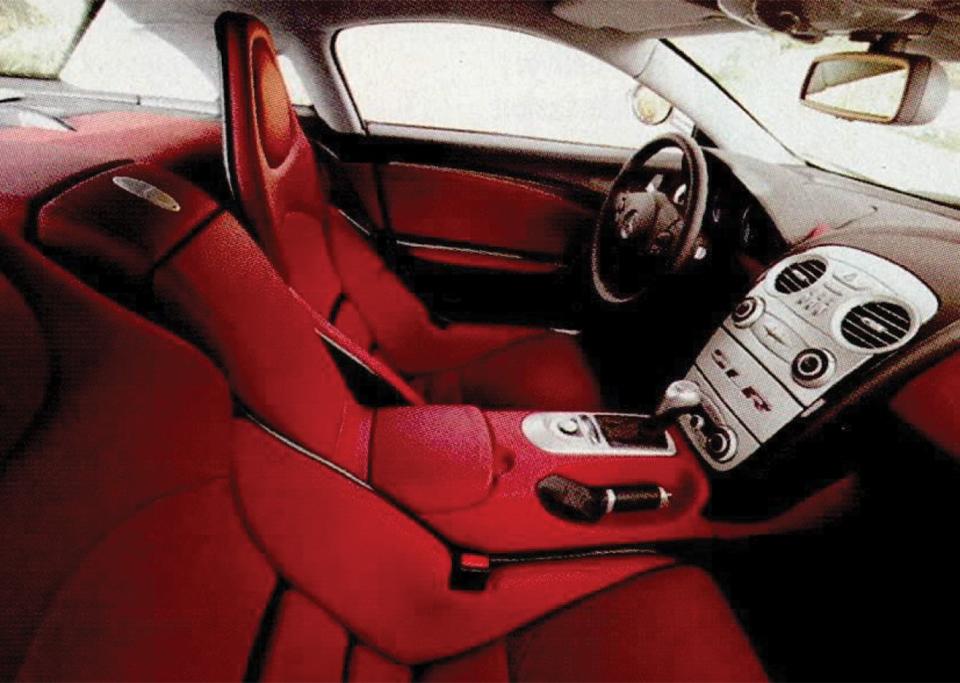
The three works of art that met up in Faenza display distinguished yet distinct parentage reflected by the creativity of their gifted designers. The Ferrari is proof of continuously evolving motorsport competence. Almost Spartan in execution and mechanically honed without compromise, it embodies aggressive sportiness.
The Porsche plays to its history on the racetrack, and yet the interior reflects a touch of luxury, a sign that critics say- in pointing to products like the Cayenne sport utility- shows that the company has lost some of its edge. But beneath the leather-trimmed interior, the Carrera GT shows that nothing has changed. Porsche still knows exactly what to do with second-to-none racing technology. This know-how shines through, turning this roadster into an impressive driving machine, reassuring purists that the spirit of today’s Porsche is more than just shareholder value.
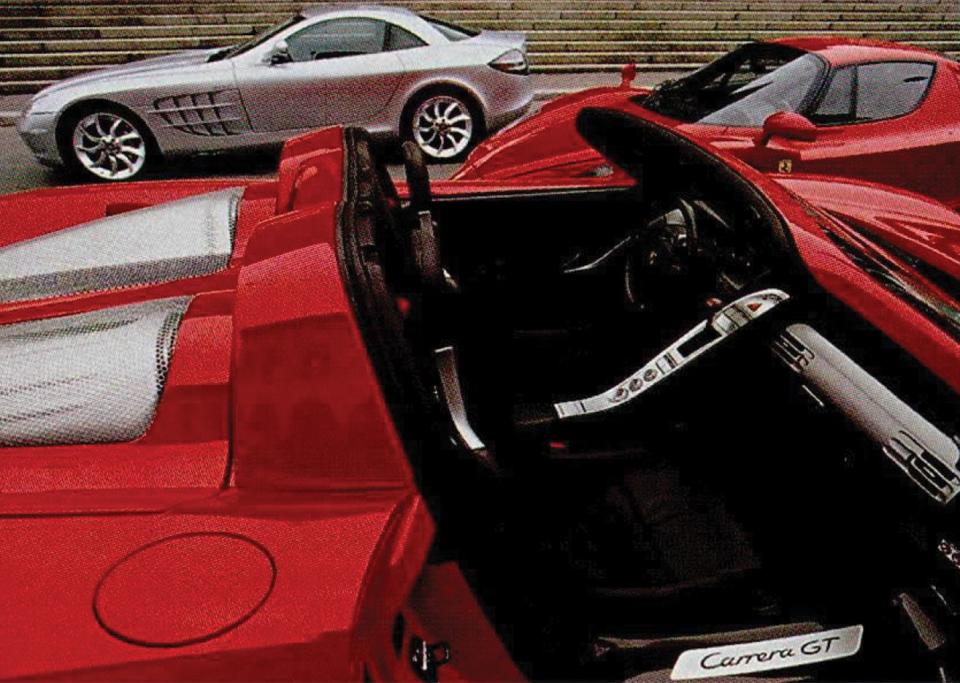
The Mercedes-Benz SLR McLaren is perhaps the most ambitious of the trio, seeking to bridge its old and new racing tradition with the mass manufacturer’s highly developed reputation for safety and comfort. Despite extensive use of carbon- fiber body panels and aluminum framing material, the SLR weighs an estimated 3735 lb. Of course, it comes with electric seat and mirror adjustment as well as the complete range of electronic driving aids: cruise control, an electrohydraulic braking system (SBC) and assisted braking (EBA).
It’s a tall order to choose among the different concepts. Preferences tend to be a personal affair. The sound generated by the 12-cylinder engine as the Ferrari springs to life is surprisingly gentle and yet causes one’s pulse to rise. The sequential gearbox clicks into 1st gear, a touch of the throttle and slowly the Enzo moves forward. At just 1000 rpm, the Enzo sings like an electric mixer. What happens next is hard to describe. Decisive acceleration is met by a sudden eruption of power accompanied by a serious hiss from the rear. The rear 345/35ZR-19 Bridgestone tires wipe across the asphalt while your neck muscles work overtime. In fractions of seconds a band of seven diodes lights sequentially at the top of the steering wheel, the rev counter needle impulsively shooting up to the 7000-rpm marker. A short flick on the shift paddle, and the Enzo leaps ahead, another flick, click, 3rd gear. The engine begins to howl now as the speedometer needle scratches the 200-km/h zone. In the blink of an eye, the car is speeding toward a right-hand bend. A serious application of the brakes digs the Ferrari into the ground. Your body pushes forward against the locked belts. The powerful deceleration is courtesy of carbon-fiber brakes with vented front and rear discs that are as large as the silver trays presented to Grand Prix winners in the 1950s. Brake manufacturer Brembo, which works with Ferrari in Formula 1, is confident that even after applying full braking 20 times, no fading will be detected.
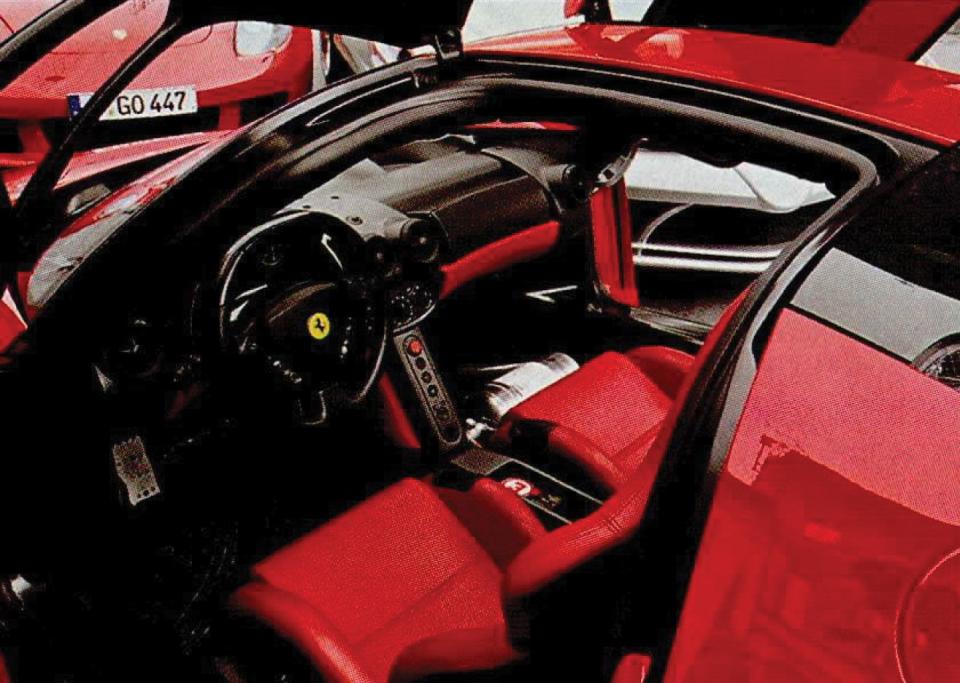
In the hands of a skilled pilot, the car can exceed 217 mph. The Enzo is capable of 0-60 mph acceleration in 3.3 seconds and has recorded a 0-124-0 mph time of 14.2 sec., thanks to 650 bhp at 7800 rpm, a curb weight of 3230 lb. and the F1 start assistance “Launch Control.” For a competition-type start, the F1-mode is activated by pressing a switch on the steering wheel, which disables the traction control. The left foot operates the brake pedal, while the throttle foot preselects the optimum engine revs for maximum torque (almost 5500 rpm). As the foot is raised off the brake pedal, the system releases the clutch and finds the ideal friction point for engagement. As if trying to escape a fire, the Enzo rockets forward, roaring through a couple of gear changes.
The Porsche Carrera GT displays similar alacrity. While its acoustics are more restrained, operating its clutch and 6-speed gearbox calls for strong calf muscles and precision footwork. Moving off is a skill test in itself. Either you carefully move into gear while the engine is idling or you let at least 4000 revs roar around your ears before engaging the clutch. Once underway you need to be vigilant in shifting. The gates are close together, the travel is short and the lever slips in almost unaided- wrong gear selection is understandable.
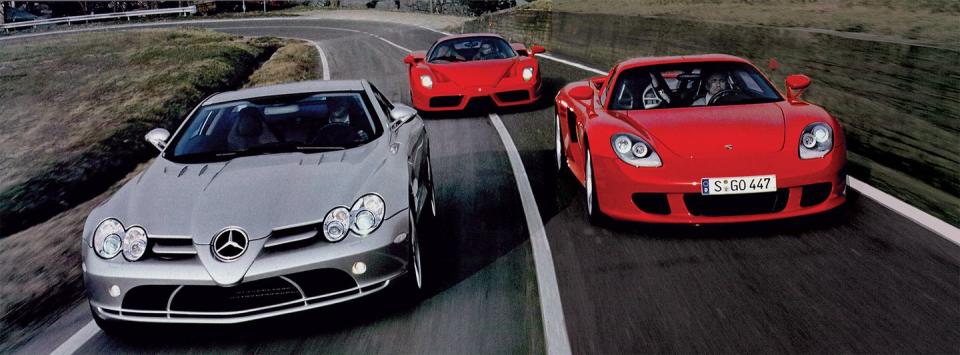
That aside, its superb aerodynamics makes the Porsche the champ at maintaining straight-line top speed. Above 180 mph, it moves with such precision that it may just as well be running on rails. The SLR McLaren displays similar calmness, sticking to the track thanks to its greater weight, although its V-8’s supercharger is somewhat less enthusiastic in its response. The Porsche is just as lively as the Enzo when braking, steering through bends and reacting to load changes. And, of course, driven at speed the Porsche presents less of a challenge. The Carrera GT sprints to 60 mph in 3.6 sec., while speed tops out at a factory-claimed 205 mph.
And although the Porsche has GT as part of its name, the Mercedes-Benz SLR McLaren is the one that presents the real Gran Turismo in this super-sports-car trio. Its interior ergonomics is largely in line with those of the Mercedes SL, which has more than proved its quality over the distance. Even so, under full load, the supercharged AMG V-8 thumps out the staccato of an American muscle car through its side pipes as it powers past the quarter mile. Under braking, it yanks its passengers vehemently forward. Yet it all happens with a sense of grandeur. Youthful eagerness is alien to this machine; the SLR McLaren bears the fine traits of mature superiority. Its statistics; acceleration from 0 to 60 mph in an estimated 3.7 sec., top speed a factory-cited 207 mph.

Which one is the best of the bunch, the citizens of Faenza are dying to know. Some smile knowingly as their gazes fix on the red Ferrari. Forza Ferrari! Yet viewed objectively, none of them is a clear-cut winner. All three are products of the way their creators interpret the expectations placed on their own brand, by being true to their respective kind. Depending on the weight attached to their individual qualities, the lead passes from one to another. And that is the secret of their success. They complement rather than compete with one another. The Enzo appeals to bold thrill seekers, the Carrera GT to those seeking technical perfection and the SLR McLaren appeals to those who yearn for the horizon in a super-fast sports car. These are the crown jewels of the the auto industry. And as the Enzo has long been sold out, as the Carrera GT will shortly follow suit and as it will take at least two years before an SLR McLaren ordered today is due for delivery, the discussion about the car of our dreams remains academic. Meanwhile, three engines tick their metallic rhythm. It will take some time before life returns to normal in Faenza.
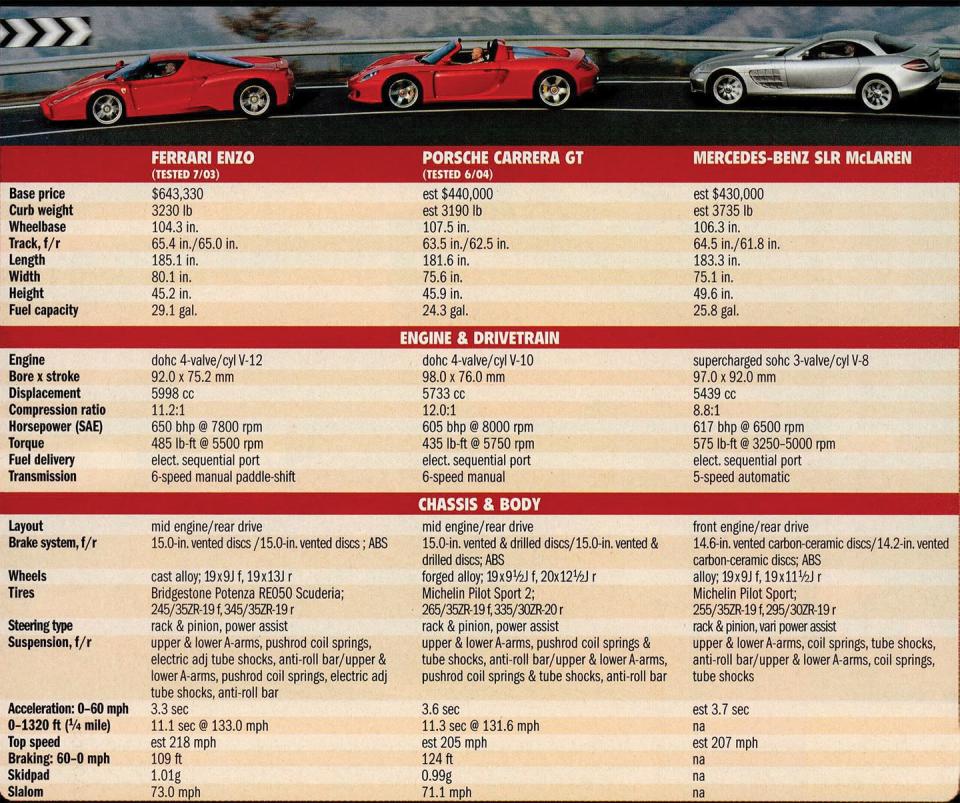
You Might Also Like

 Yahoo Autos
Yahoo Autos 